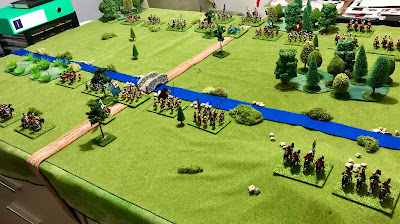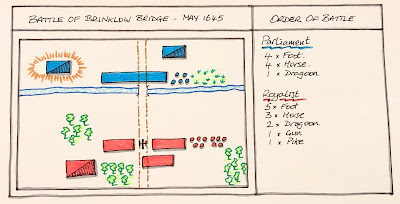During the WW2 mini campaign I used the following rules to play out the actions on the tabletop. They are very much based upon the WW2 rules from "One-Hour War-games" by Neil Thomas. No surprise there, as this book got me back into historical wargaming with its pared down rule systems and small tabletop needs. However, they do use a different activation mechanism with movement and shooting having very similar rule mechanisms.
The rules started out as a series of notes which have finally been written up and is a first draft, and will no doubt include the usual typos and spelling errors. I am not a good proofreader and my eyes are starting to glaze over.
The choice of these simple rules were so the tabletop action, or actions in some cases, could be played quickly in an evening or weekend. This way the campaign would not get bogged down with the resulting loss of interest on my part.
Units
Each player’s army has a selection of units representing platoon and troop size units. Each unit has two bases which must remain within 1” of each other during the game. Base sizes do not matter in this game providing there is a level of consistency.
All units have an assigned class which is used when determining shooting results.
Infantry types:
- Infantry units
- Armoured infantry after 1 base loss
Gun types:
- Mortars
- AT Guns
- Artillery
Armoured types:
- Armoured Infantry
- Armoured Cars
- Tank
- Self-Propelled AT Gun/Tank Destroyer
 |
| An armoured infantry unit with two bases. The unit is treated as armoured until the first base is lost, then the half-track base is removed and the remaining base operates as infantry. |
 |
| AT gun unit with a transport base and gun base. Only the AT gun base can shoot. Hits are taken against the transport unit which when removed will reduce movement to 6". |
 |
| Mo rtar unit with a transport base and mortar base. Only the mortar base can shoot. Hits are taken against the transport unit which when removed will reduce movement to 6". |
Sequence of Play
Using a shuffled set of playing cards deal a card for each unit, placing the card face up beside each unit.
Units are then activated from the highest value card to the lowest. When activated a unit can move or shoot.
Off-table artillery and air support can only shoot when receiving a red suited card.
Unit Movement
All units must move in straight lines.
Any unit moving into cover can only move a maximum of 6” for an activation.
Terrain
Open Terrain - no effects
Buildings - all units can enter, but only infantry can claim cover
Woods - only can enter infantry and claim cover
Marshland/Lakes - are impassable to all units.
Fields - all units can enter, but only infantry can claim cover
Rivers - Units may only cross rivers at bridges & fords. Rivers do not block line of sight.
Roads - no effect.
Hills - block line of sight & Tank units are able to be “hull down” & treated as in cover for combat.
Observation
Units may only shoot units they can see. All units can observe units at a range of 12” providing their line of sight is blocked by terrain or smoke.
Units have a 90 degrees of observation from the front edge of either unit base.
The exception to the observation rule is indirect fire from Artillery & Mortars, which can attack units they cannot see providing a friendly infantry or reconnaissance unit can observe the target & radio in the coordinates.
 |
| Both bases have individual 90 degree fields of fire. This allows a two base unit to increase its field of fire by careful positioning of both bases. Single base units and AT guns only have the single 90 degree field of fire. |
 |
| An example of the AT guns single 90 degree field of fire compared to an armoured and mobile AT unit. |
Shooting
Units cannot move and shoot.
Direct shooting bases have a 90 degree field of fire. Only one base needs to observe a target in the field of fire for a unit to shoot or call in artillery support.
Artillery and mortars when not direct shooting don't use a field of fire. However, after targeting a unit they cannot switch to another target in the following turn without a break of one turn.
Determine if in range.
To determining damage roll 1 D6 and make adjustments in the table below. When increasing or reducing by 50% any fractions are rounded up to the attacker's advantage.
The result is further reduced by 50% for:
- Infantry in woods, buildings, or positioned behind armoured units.
- Tanks (not other armoured units) hull down on a hill.
 |
| An infantry unit seeking cover behind an advancing tank unit. |
Target units which cannot claim cover and are yet to be activated at can sacrifice their card and take evasive action. They are then treated as being in cover reducing the hits by 50%. For infantry that is going to ground, other units must retire out of range. However, the attacking unit must be in their field of fire to take evasive action.
 |
| An infantry unit (9 spades) has been flanked by the armoured car unit (Queen diamonds) and cannot take evasive action. Having a narrow field of fire and this rule to evasion encourages flanking moves on the tabletop. |
 |
| The this example an infantry unit (9 spades) positioning of its bases means it can sacrifice its card and take evasive action to reduce the shooting hits from an armoured car unit (Queen diamonds). |
Split units, such as armoured infantry, will always be treated as armoured until the half-track base is removed. Then on after they are treated as infantry and operate like infantry when taking hits.
 |
| This armoured infantry unit will now be operating as an infantry unit only. |
Elimination
Units are eliminated after 14 hits. When 7 hits are taken remove one base. This means hits can be recorded on a single dice as the 7 or 14th hit removes a base.
The removal of one base limits a unit’s field of fire as the combination of two base's field of fire when carefully positioned increase the field of fire.
Optional Rules
Smoke Screens - Artillery & Mortar units may provide smoke screens. On a score of 4+ place 6” of smoke which blocks line of sight. All smoke is removed at the start of turn.
Aircraft Sorties - On a read suited card air support can attack any unit not in woods or buildings. Air support attack as AT guns.
AA Guns - If there is an AA gun within 12” of the unit being shot at by air support reduce hits by 50%.
Wrecks - Mark eliminated armoured based with smoke. If behind these wrecks units can be treated as in cover. The wrecks do not block line of sight.























































